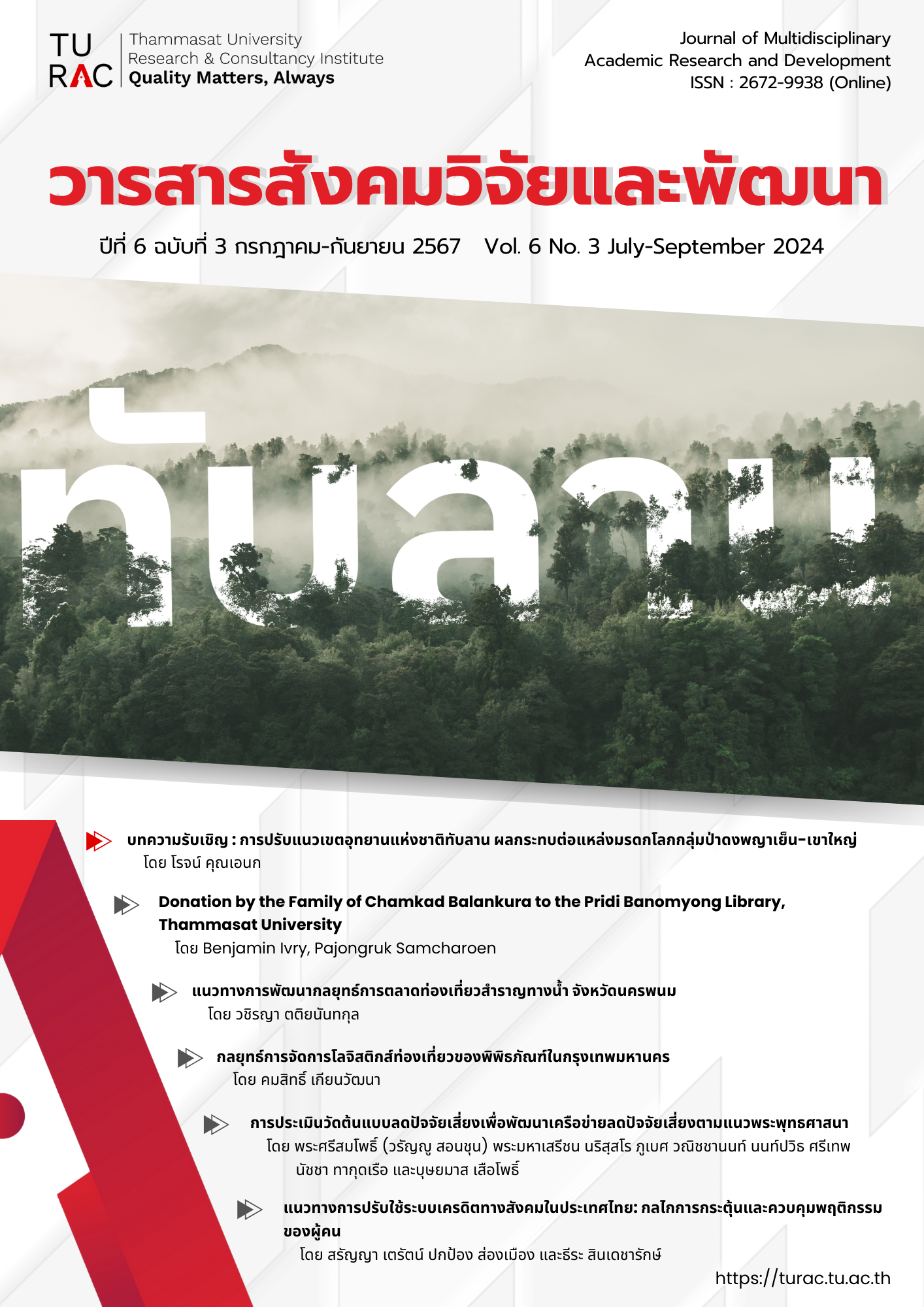Guidelines for Developing Marketing Strategies of River Tourism in Nakhon Phanom Province
Keywords:
Tourism Marketing, Tourism Marketing Strategy, Water-based tourism, 8P's Tourism Marketing Mix, Internal and External Environmental Analysis (SWOT Analysis)Abstract
This study aims to examine the management conditions of water-based tourism in Nakhon Phanom Province by analyzing the internal and external environments related to tourism development and proposing marketing strategies to guide its advancement. Utilizing in-depth interviews with a purposive sample of 14 key informants, small group discussions, and quantitative data from a survey of 400 tourists, the research employs SWOT and TOWS matrix analysis to identify effective strategies. The findings suggest the following development strategies; Product Strategy : emphasizes the province's unique location along the Mekong River and diversifying water tourism activities; Pricing Strategy: implementing appropriate pricing that reflect quality and experience; Promotion Strategy: using promotion that focusing on modern communication channels to promote an impressive tourism image and special water excursions combined with hotel reservations; aligning Distribution Channels Strategy with target group behaviors; using the Service Provider Strategy involves training and developing employees to create a favorable impression and satisfaction; Process Strategy: ensure that the delivery of products and services is easy, convenient and fast, adaptable to market changes and tourist behavior; Physical Evidence Strategy: highlighting the riverside city's simple, slow lifestyle and ethnic culture; Programming Strategy: developing cooperated tour programs strategy with local tourist attractions to offer comprehensive water-based tourism packages.
References
กระทรวงการท่องเที่ยวและกีฬา. (2566). แผนพัฒนาการท่องเที่ยวแห่งชาติ ฉบับที่ 3 (พ.ศ. 2566 - 2570). สืบค้นจาก http://article_20230418122435.pdf (mots.go.th).
ประจวบ จันทร์หมื่น. (2565). การบูรณาการแผนการท่องเที่ยวเชิงอนุรักษ์สังคมและวัฒนธรรม ในพื้นที่ลุ่มน้ำโขงไทย-ลาว จังหวัดนครพนมถึงจังหวัดอุบลราชธานีและแขวงคำม่วนถึงแขวงจำปาสัก. วารสารมนุษยศาสตร์และสังคมศาสตร์มหาวิทยาลัยนครพนม. 12(1), 82-95.
ปัฐมาภรณ์ พงษ์ไพบูลย์ ชัยพล หอรุ่งเรือง และปริญ ลักษิตามาศ. (2563). รูปแบบกลยุทธ์การตลาดเพื่อการสร้างสรรค์สินค้าของที่ระลึกสำหรับการท่องเที่ยวไทย ในมุมมองนักท่องเที่ยวต่างชาติอาเซียน. Academic Journal of Thailand National Sports University. 12(3), 58-71.
มนตรี คำวัน และ คู่บุญ จารุมณี. (2560). โอกาสและความท้าทายของการพัฒนานครพนมเป็นเมืองท่องเที่ยวริมฝั่งแม่น้ำโขง. วารสารการเมืองการปกครอง. 7(3), 163-178.
ฤดี เสริมชยุต. (2563). กลยุทธ์การส่งเสริมการตลาดสำหรับการท่องเที่ยวชุมชน. วารสารสังคมวิจัยและพัฒนา. 2(4), 51-61.
ศิวธิดา ภูมิวรมุนี. (2561). แนวทางการส่งเสริมการท่องเที่ยวเชิงวัฒนธรรมของจังหวัดนครพนม, (วิทยานิพนธ์ปริญญาดุษฏีบัณฑิต, สาขาการจัดการการท่องเที่ยว, มหาวิทยาลัยพะเยา).
สำนักงานการท่องเที่ยวและกีฬาจังหวัดนครพนม. (2561). สถิตินักท่องเที่ยวจังหวัดนครพนม. สืบค้นจาก http://www.nakhonphanom.mots.go.th/graph_views.php?graph_id=41.
สำนักงานปลัดกระทรวงการท่องเที่ยวและกีฬา. (2563). โครงการจัดทำข้อมูลตามตัวชี้วัด ตามแผนแม่บทภายใต้ยุทธศาสตร์ชาติ ประเด็นการท่องเที่ยว (พ.ศ. 2561 – 2580). สืบค้นจาก http://www. article_20220222135024.pdf (mots.go.th).
สุประภา สมนักพงษ์. (2560). แนวโน้มและตลาดการท่องเที่ยว 4.0 ประเทศไทย. Veridian E-Journal, Silpakorn University ฉบับภาษาไทย สาขามนุษยศาสตร์ สังคมศาสตร์ และศิลปะ. 10(3), 2055-2068.
Abbas, E. W. (2021). Portrait of Tourism Based on River Tourism in Banjarmasin. The Kalimantan Social Studies Journal. 3(1), 18-26.
Dolnicar, S. & Ring, A. (2014). Tourism Marketing Research - Past, Present and Future. Annals of Tourism Research. 47, 31-47.
Fachrudin H. T., & Lubis M.D. (2016). Planning for Riverside Area as Water Tourism Destination to Improve Quality of Life Local Residents, Case Study: Batuan–Sikambing River, Medan, Indonesia. Procedia - Social and Behavioral Sciences. 234, 434-441.
Goeldner, J. R. & Ritchie, B. (2012). Tourism: Principles, Practices, Philosophies. 12th ed. Hoboken, N.J.: JOHN WILEY & SONS.
Kotler, P. T. & Armstrong, G. (2014). Principles of Marketing. 15th ed. Harlow, UK: Pearson.
Kotler, P., Bowen, J., Makens, J. & Baloglu, S. (2017). Marketing for Hospitality and Tourism. 7th ed. Malaysia: Pearson Education Limited.
Kotler, P., Armstrong, G., Wong, V., & Saunders, J. (2008). Principles of Marketing. Prentice Hall, London.
Łapko, A., & Panasiuk, A. (2019). Water tourism as a recipient of transport services on the example of Szczecin. Transportation Research Procedia. 39, 290-299.
Misiura, S. (2006). Heritage Marketing. Oxford: Butterworth-Heinemann.
Morrison, A. M. (2019). Marketing and Managing Tourism Destination. 2nd ed. New York: Routledge.
The American Marketing Association. (2017). Definitions of Marketing. Retrieved from https://www.ama.org/the-definition-of-marketing-what-is-marketing.
Van Balen, M., Dooms, M., & Haezendonck, E. (2014). River Tourism Development: The Case of the Port of Brussels. Research in Transportation Business & Management. 13, 71-79.
Victor T. C. Middleton, A. F. (2009). Marketing in travel and tourism. 4th ed. Jordan Hill, Oxford: Routledge.
Weaver, D. & Lawton, L. (2010). Tourism Management. 4th ed. Milton Qld: John Wieley & Sons, Australia.
Downloads
Published
How to Cite
Issue
Section
License
Copyright (c) 2024 Journal of Multidisciplinary Academic Research and Development (JMARD)

This work is licensed under a Creative Commons Attribution-NonCommercial-NoDerivatives 4.0 International License.



